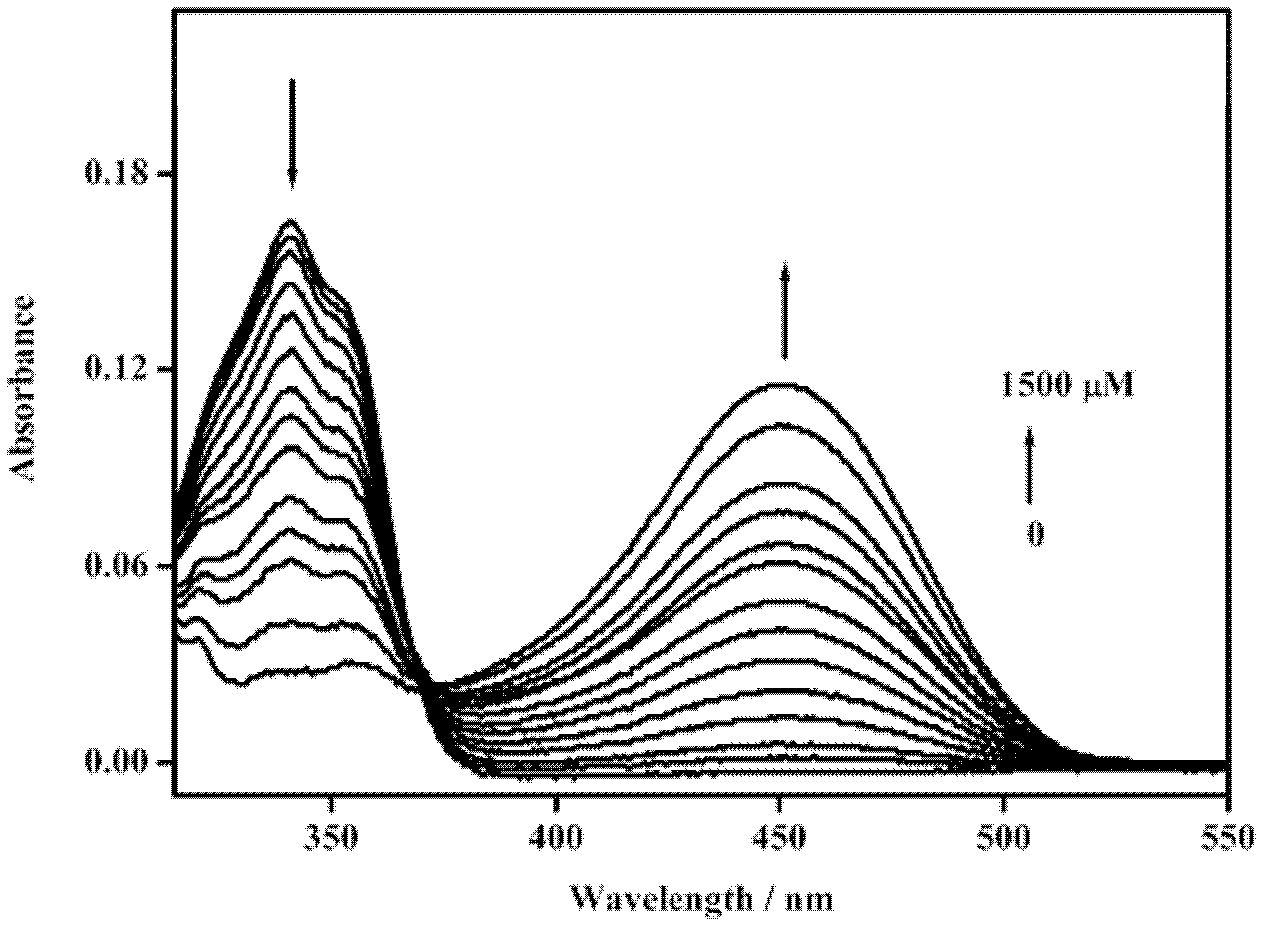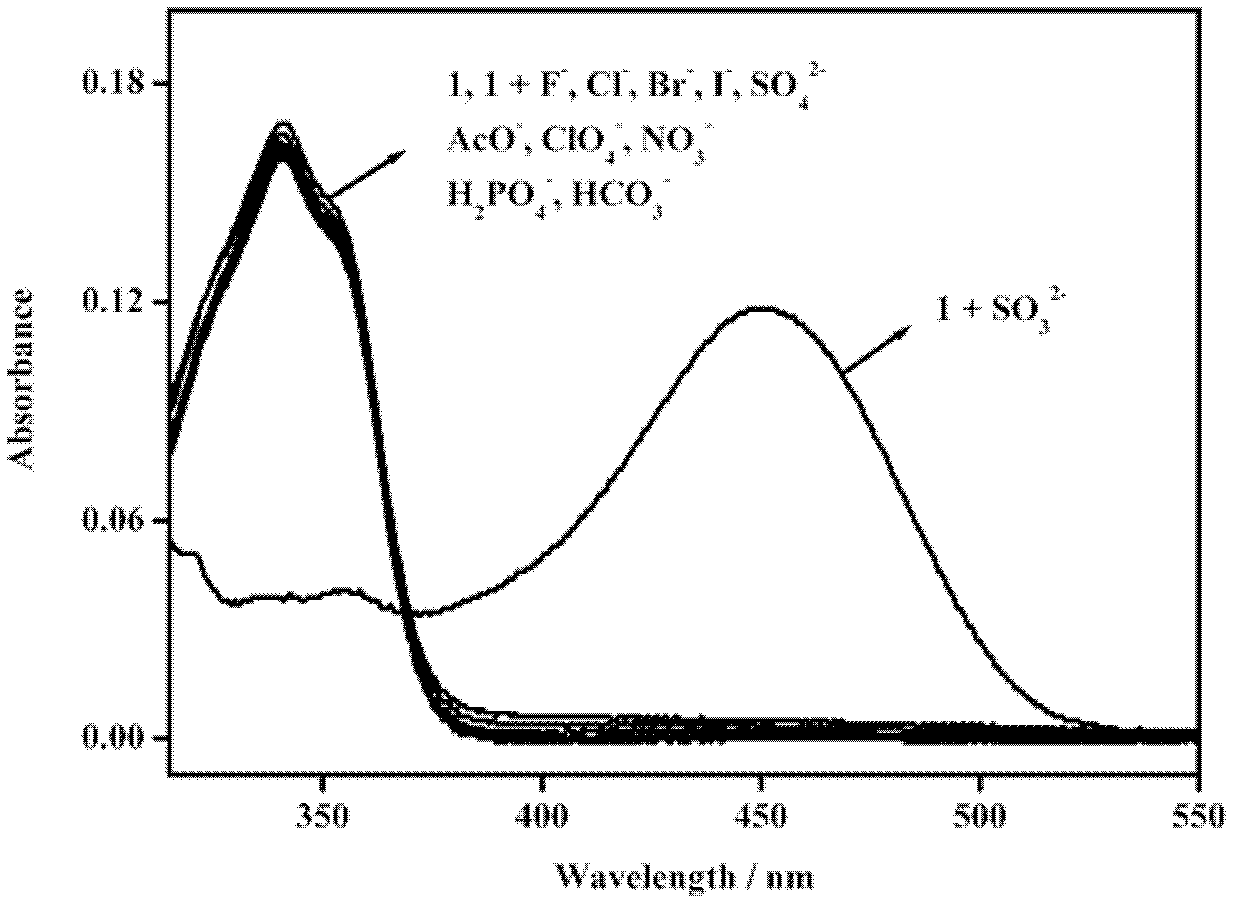Fluorescent molecular probe for detecting sulfite ions through naked eyes and fluorescence ratio as well as synthesis and application thereof
A fluorescent molecular probe and sulfite technology, which can be used in fluorescence/phosphorescence, color/spectral characteristic measurement, luminescent materials, etc., can solve the problems of limited application, fluorescence intensity enhancement, etc., and achieve wide detection range and high synthesis yield , the effect of stable fluorescence performance
- Summary
- Abstract
- Description
- Claims
- Application Information
AI Technical Summary
Problems solved by technology
Method used
Image
Examples
Embodiment 1
[0030] Embodiment 1: Preparation of Molecular Fluorescent Probe 1
[0031] 269mg (1mmol) of 4-hydroxynaphthalimide, 309mg (1.5mmol) of 1,3-dicyclohexylcarbodiimide (DCC), 73mg (0.6mmol) of 4-dimethylaminopyridine, 150mg (1.3 mmol) was added into 30 mL of dichloromethane, and refluxed for 4 hours. Then the temperature was lowered, and 20 mL of water was added to quench the reaction. Extracted three times with dichloromethane and washed with saturated sodium chloride. It was dried over anhydrous sodium sulfate and separated by column chromatography to obtain 165 mg (45%) of the probe compound as a white solid 1 .
[0032] 1 H NMR (400MHz, CDCl 3 ): δppm = 8.64-8.59 (m, 2H), 8.37 (d, J = 8.8Hz, 1H), 7.81 (t, J = 7.6Hz, 1H), 7.52 (d, J = 8.0Hz, 1H), 4.18 (t, J=7.6Hz, 2H), 3.03-3.01(m, 2H), 2.99-2.97(m, 2H), 2.27(s, 3H), 1.71(s, 2H), 1.44(d, J=7.6 Hz, 2H), 0.98(t, J=7.6Hz, 3H)
Embodiment 2
[0033] Example 2: Preparation of Molecular Fluorescent Probe 1
[0034] 269mg (1mmol) of 4-hydroxynaphthalimide, 131mg (1.3mmol) of triethylamine, 73mg (0.6mmol) of 4-dimethylaminopyridine, and 175mg (1.3mmol) of levulinyl chloride were added to 30mL of dichloromethane, room temperature Stir for 4 hours. Then the temperature was lowered, and 20 mL of water was added to quench the reaction. Extracted three times with dichloromethane and washed with saturated sodium chloride. It was dried over anhydrous sodium sulfate and separated by column chromatography to obtain 158 mg (43%) of the probe compound as a white solid 1.
[0035] 1 H NMR (400MHz, CDCl 3 ): δppm = 8.64-8.59 (m, 2H), 8.37 (d, J = 8.8Hz, 1H), 7.81 (t, J = 7.6Hz, 1H), 7.52 (d, J = 8.0Hz, 1H), 4.18 (t, J=7.6Hz, 2H), 3.03-3.01(m, 2H), 2.99-2.97(m, 2H), 2.27(s, 3H), 1.71(s, 2H), 1.44(d, J=7.6 Hz, 2H), 0.98(t, J=7.6Hz, 3H)
Embodiment 3
[0036] Embodiment 3: The application of naked eye and fluorescence ratio detection sulfite ion fluorescent probe
[0037] The probe was dissolved in acetonitrile solution, and the corresponding anion buffer was added to prepare 10×10 -6 M (acetonitrile: HEPES buffer = 1: 1) solution, test its ultraviolet absorption spectrum and fluorescence spectrum changes. Figure 1-Figure 11 It shows that the probe has high selectivity to sulfite ions in the ultraviolet spectrum and fluorescence spectrum. With the increase of the concentration of sulfite added, the ultraviolet spectrum and fluorescence spectrum are obviously red-shifted, and the color of the solution changes. The color change is also suitable for naked eye detection, while the fluorescence changes from blue to yellow. And the probe is not affected by F - , Cl - , Br - , I - , HPO 4 2- , SO 4 2- , NO 3 - , AcO - , ClO 4 - , N 3 - , HCO 3 - The influence of other anions. The probe responds well to sulfite io...
PUM
 Login to View More
Login to View More Abstract
Description
Claims
Application Information
 Login to View More
Login to View More - R&D
- Intellectual Property
- Life Sciences
- Materials
- Tech Scout
- Unparalleled Data Quality
- Higher Quality Content
- 60% Fewer Hallucinations
Browse by: Latest US Patents, China's latest patents, Technical Efficacy Thesaurus, Application Domain, Technology Topic, Popular Technical Reports.
© 2025 PatSnap. All rights reserved.Legal|Privacy policy|Modern Slavery Act Transparency Statement|Sitemap|About US| Contact US: help@patsnap.com



